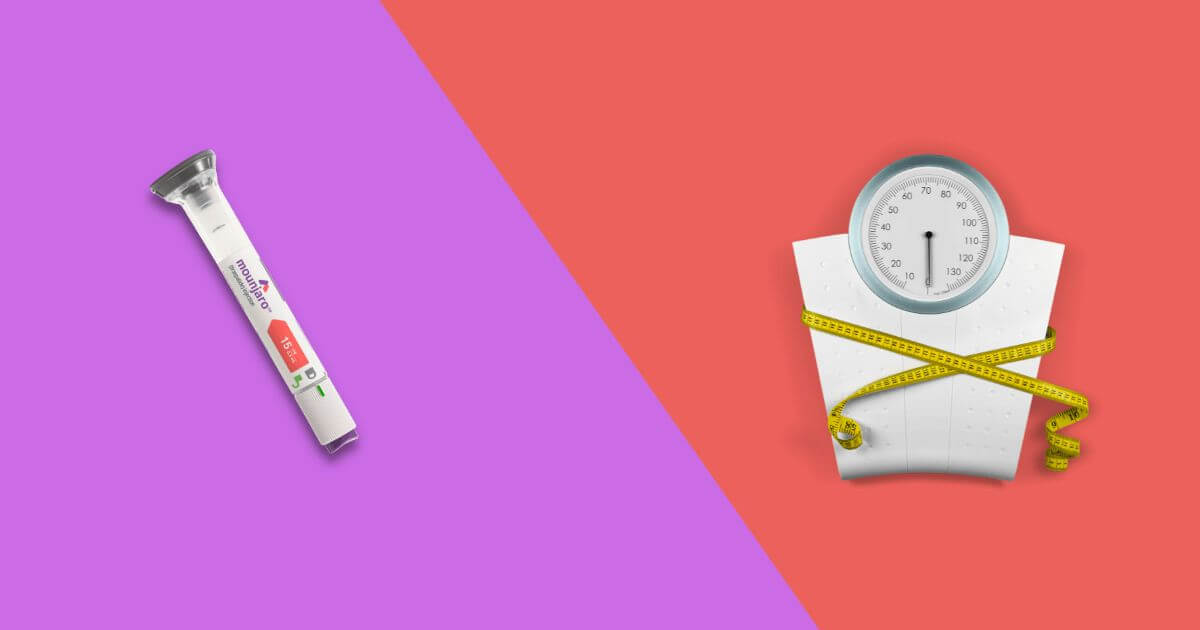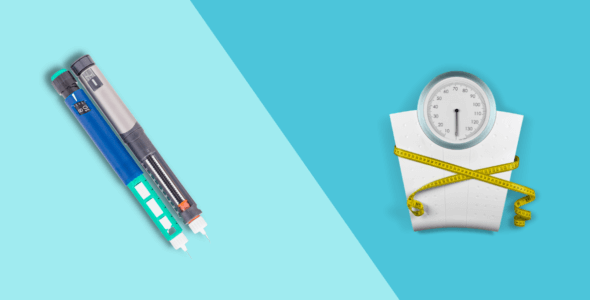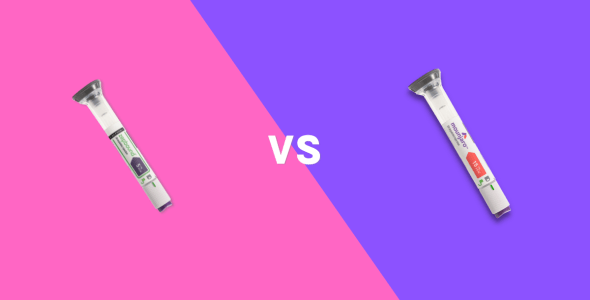How does Mounjaro (tirzepatide) work for weight loss?
Key highlights
- Mounjaro is an FDA-approved prescription drug for controlling blood sugar levels in people with Type 2 diabetes and is also used off-label for weight loss in people with obesity or overweight.
- Mounjaro is the only GLP-1 to activate both GLP-1 and GIP receptors, so it may be more effective for weight loss and blood sugar control than alternative medications.
- Nausea, vomiting, and abdominal pain are common gastrointestinal side effects, but they usually go away as your body gets used to the medication.
- If you experience unusual reactions that do not go away, speak to your healthcare provider for medical advice.
Mounjaro (tirzepatide) is a popular FDA-approved injectable medication for Type 2 diabetes. Mounjaro is not approved for weight loss but some doctors may prescribe it off-label to help in weight management in people with obesity (body mass index of 30 or more) and overweight (body mass index of 27 or more) with other weight related conditions.
Mounjaro works by activating both GLP-1 and GIP receptors, increasing insulin secretion, decreasing glucose production by the liver, reducing hunger and cravings, and promoting satiety leading to less food intake and weight loss.
Mounjaro is a helpful treatment in the fight against obesity and related health problems, offering an effective way for people to lose weight and maintain it.
Let’s explore how Mounjaro works to help you lose weight, its potential side effects, and how it can be used safely and responsibly.
What is Mounjaro?
Mounjaro (tirzepatide) is a prescription injectable medication approved by the FDA (U.S. Food and Drug Administration) in 2022 to help lower blood sugar levels in adults with Type 2 diabetes. It is also prescribed off-label for weight loss when combined with diet and exercise.
Mounjaro works by activating two gut hormones: glucagon-like peptide-1 GLP-1 and glucose-dependent insulinotropic polypeptide GIP receptor in the brain and the pancreas. This helps regulate insulin after meals, controls blood sugar, slows stomach emptying, and reduces appetite, which leads to eating less and consequently losing weight.
This dual action may make Mounjaro more effective for weight management and blood glucose control than other GLP-1 medications that target only one receptor, like Ozempic and Wegovy which contain the active ingredient, semaglutide.
The brand names Ozempic and Mounjaro are not approved by the FDA for weight loss, but similar medications made by the same companies with the same active ingredients are approved for weight loss under the names Wegovy and Zepbound respectively.
Tirzepatide, the ingredient in Mounjaro, helps reduce hunger and make you feel full by affecting the hormones that control appetite. It can also help boost metabolism and burn fat.
How does Mounjaro work?
Mounjaro works in several ways to help with blood sugar control and weight management:
- Regulates blood sugar by increasing insulin: Mounjaro is a GLP-1 receptor agonist that makes your body release insulin when blood sugar is high which lowers blood sugar.
- Slow down digestion to reduce post-meal glucose spikes: Mounjaro slows down digestion which prevents glucose spikes after eating.
- Suppresses appetite to aid in weight management: It reduces hunger, makes you feel full for longer, and reduces food intake which helps you eat less and lose weight.
- Reduces liver glucose production: It reduces the glucose produced by the liver which helps to keep your blood sugar levels more stable.
Mounjaro, manufactured by Eli Lilly, is a subcutaneous injection that you inject once weekly under the skin of your upper thigh, back side of your upper arm, or abdomen (stomach).
How does Mounjaro work for weight loss?
Mounjaro makes the body more insulin-sensitive. This means cells take in sugar from the blood faster, less calories in, and less fat stored. It also reduces hunger and cravings by releasing hormones that make you feel full. By being more insulin sensitive, it burns fat and stops fat from building up in cells.
Studies show that Mounjaro can help you lose significant body fat and weight, and boost metabolism and fat burning. It also improves cholesterol, blood sugar, and reduces hunger and cravings.
Benefits of Mounjaro’s mechanism of action
Mounjaro works differently than other GLP-1 weight loss drugs and is the first and only approved single molecule that activates both GIP and GLP-1 receptors in the body. It enhances insulin secretion, improves insulin sensitivity, decreases food-intake, slows gastric emptying, and reduces blood sugar levels. Mounjaro has many benefits including:
- Lower HbA1c levels and long-term blood sugar control: Mounjaro lowers HbA1c which is a measure of long-term blood sugar control. By increasing insulin sensitivity, it helps people with type 2 diabetes manage their blood sugar over time.
- Weight loss for patients with obesity (BMI 30 or more) or overweight (BMI 27 or more): Mounjaro reduces hunger and increases feelings of fullness, so you eat less and lose weight. This is great for people with obesity or those who are overweight as it can lead to significant weight loss and a reduced risk of weight-related health conditions.
- Cardiovascular risk and metabolic health: By controlling blood sugar and weight loss, Mounjaro reduces heart disease risk and improves overall metabolic health. This means better cholesterol, blood pressure, and a healthier heart.
Is Mounjaro right for me?
Mounjaro may be right for you if you have type 2 diabetes, obesity, or prediabetes. It is designed to help manage blood sugar levels and promote weight loss in people with these conditions.
- Type 2 diabetes: Mounjaro helps control blood sugar levels by improving insulin sensitivity, which is important for managing type 2 diabetes.
- Obesity: If you are struggling with obesity, Mounjaro can aid in weight loss by reducing hunger and increasing feelings of fullness. While not approved for treatment of obesity, Mounjaro is commonly prescribed off-label for weight loss.
- Prediabetes: Mounjaro can help prevent the progression of type 2 diabetes by improving blood sugar control and supporting weight loss.
If you have one of these conditions and are considering Mounjaro, it’s essential to speak with your doctor. They will evaluate your overall health, medical history, current medical conditions, and any other medications you’re taking to determine if Mounjaro is a good fit for you and if it will help you reach your health goals.
How is Mounjaro different from other medications?
Mounjaro is different than other diabetes drugs like Ozempic and other traditional GLP-1 agonists because it activates both receptors GLP-1 and GIP, whereas other medications only activate one receptor which is GLP-1.
Ozempic works by activating the GLP-1 receptor to control blood sugar and help in weight reduction, while Mounjaro also activates the GIP receptor to enhance metabolism, fat-burning, and weight loss.
This dual receptor activation makes Mounjaro unique, and it is more effective for blood sugar control and weight loss compared to other GLP-1 drugs.
In a study that compared Mounjaro vs Ozempic, Mounjaro (in doses of 5 mg, 10 mg, and 15 mg) worked more effectively than the 1 mg dose of Ozempic. Mounjaro improved blood sugar control and helped people lose more weight. For example, people taking the 15 mg dose of Mounjaro lost nearly twice as much weight as those on Ozempic.
A study found that over 18 months, people with type 2 diabetes who took 15 mg of tirzepatide (the active ingredient in Mounjaro) lost an average of 18% of their body weight, compared to 12.4% for those taking 2.4 mg of semaglutide.
Mounjaro side effects
While Mounjaro can help with lowering blood sugar levels and promotes weight loss, it’s important to be aware of possible side effects and safety tips when using this medication.
The most common side effects of Mounjaro may include:
- Nausea
- Diarrhea
- Vomiting
- Decreased appetite
- Constipation
- Upset stomach
- Headache
- Abdominal (stomach) pain
These side effects occur because Mounjaro works by influencing hormones that regulate hunger and digestion, which can sometimes lead to an upset stomach, changes in how your body processes food or a feeling of fullness. The medication also helps reduce appetite, which might cause you to eat less or feel less hungry, leading to these changes.
Other more serious side effects of Mounjaro weight loss medication, especially with higher doses include:
- Blurred or changed vision
- Low blood sugar (hypoglycemia)
- Gallbladder problems
- Depression or anxiety
- Serious allergic reactions
- Pancreatitis (Inflammation of the pancreas)
If you have any of these side effects, speak with your doctor right away.
Before taking Mounjaro for weight loss, talk to your doctor about any allergies and any other medications or supplements you’re taking, as they might affect how the medicine works. Let your doctor know if you have kidney disease or other health problems, as they could impact how your body handles the medication. You should not take Mounjaro if you are pregnant or breastfeeding.
Mounjaro is not recommended for people with serious kidney or liver problems, or a type of thyroid cancer or tumors called medullary thyroid carcinoma (MTC).
Tips to manage side effects
Here are some tips to manage the side effects of Mounjaro and make it easier to stick to your treatment:
- Eat smaller meals more often: Instead of big meals, eat smaller meals throughout the day. This will help with nausea and stomach upset.
- Stay hydrated: Drink lots of water to help with digestion and prevent dehydration especially if you’re having diarrhea.
- Avoid heavy, greasy, or spicy food: These types of food will make stomach discomfort and digestive issues worse.
- Take as directed: Follow your healthcare provider’s instructions and try to take the medication on the same day every week.
- Rest when you need to: If you’re feeling nauseous or tired, let your body rest and recover.
- Talk to your doctor: If side effects persist or are too uncomfortable, talk to your doctor for advice on how to manage them better or change your treatment plan. They may adjust your dose or suggest ways to minimize them.
Frequently asked questions
How long does it take for Mounjaro to work?
It may take several weeks for Mounjaro to work for weight loss. Many people start to feel changes in appetite and weight within 4 to 12 weeks of taking the medication, but it may vary from person to person. Being consistent with the medication along with a healthy diet and exercise can help speed up the process and see better results over time.
How do I know if Mounjaro is working?
You’ll know Mounjaro is working if you feel less hungry and start to lose weight over time. Most people see a decrease in appetite and some weight loss within a few weeks of taking the medication.
How much weight can you lose on Mounjaro?
Weight loss on Mounjaro varies from person to person, but studies show an average of about 1% weight loss per week for the first 4 weeks. Another study shows that people taking the 15 mg weekly dose of Mounjaro lost an average of 22.5% of their body weight after 72 weeks.
Weight loss results may vary based on diet, exercise, strength of medication you’re taking, and how your body responds to the medication.
How long do you need to take Mounjaro?
The length of time you need to take Mounjaro depends on your weight loss goals and how your body responds to the medication. A study shows that people re-gained up to 14% of their body weight after stopping Mounjaro. Your healthcare provider will guide you on how long to continue treatment based on your progress and overall health.
Is it safe to use Mounjaro long-term?
Mounjaro is generally considered safe for long-term use or to prevent weight gain when taken as directed by a healthcare professional. However, your doctor will monitor your health regularly to make sure the medication is working for you and to check for any potential side effects.
Can Mounjaro be used with other medications?
Mounjaro can be taken with other medications but always talk to your doctor about other medications you are taking. Some medications, especially other diabetes medications, may interact with Mounjaro, and affect how it works or cause side effects. Your doctor will review your current medications and adjust the dose if necessary to ensure safety and efficacy.
Bottom line
Mounjaro is an FDA-approved medication for type 2 diabetes. Although it’s not approved specifically for weight loss, it can help with weight loss in people with obesity or overweight when used off-label.
Mounjaro works by activating GLP-1 and GIP receptors, increasing insulin sensitivity, reducing hunger, and promoting weight loss. It’s the first and only single molecule with this dual action and has proven to be more effective than other GLP-1 drugs like Ozempic.
Consider making healthy lifestyle changes, like eating well, staying hydrated, and increasing physical activity to enhance the effectiveness of your treatment.
Always consult your healthcare provider before using Mounjaro, especially if you’re taking other medications, to ensure it’s safe and effective for you.









